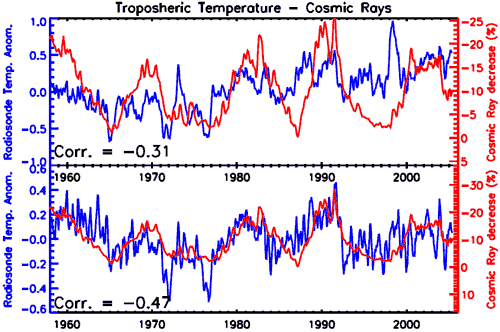Svensmark and Friis-Christensen rebut Lockwood's solar paper
Posted on 8 October 2007 by John Cook
Recently, Henrik Svensmark and Eigil Friis-Christensen published Reply to Lockwood and Fröhlich - The persistent role of the Sun in climate forcing, rebutting Mike Lockwood's Recent oppositely directed trends in solar climate forcings and the global mean surface air temperature. It's a curious paper, in some parts reading more like a skeptic op-ed than scientific literature. In just a few paragraphs, they hint that human CO2 effect is minor compared to natural greenhouse gases, cast doubt on the surface temperature record, claim global warming stopped in 1988 and invoke water vapor as the most powerful greenhouse gas. These are just minor points on the way to their major conclusion that the sun and cosmic rays are the "main forcing agent in global climate change".
They look at tropospheric and ocean temperature data while ignoring surface air temperature which they say doesn't respond to the solar cycle. This is a surprising claim - Camp & Tung 2007 find a strong 11 year solar cycle signal in global surface temperature records. I discuss the significance of Tung's paper in more detail in Solar cycles and global warming.
However, the real eye opener is when they correlate tropospheric temperature with cosmic rays. The figure below features two graphs. The first graph compares tropospheric temperature (blue) to cosmic rays (red). The second graph removes El Nino, volcanoes and a linear warming trend of 0.14°C per decade. With the warming trend and other "confusions" removed, the negative correlation between cosmic rays and temperature is very high.

The conclusion is obvious - the warming trend over the past several decades has a source other than cosmic rays. Or another way of looking at it - the long term contribution of cosmic rays to global temperatures has been little to nothing (possibly slightly negative). I'm considering whether to use their graph to further debunk the cosmic rays argument.
Lastly, I fail to understand why most seem to forget Lockwood is only the latest in a long line of studies on the topic. Ammann 2007, Foukal 2006, Scafetta 2006, Usoskin 2005, Haigh 2003, Solanki 2003, Stott 2003, Lean 1999, Waple 1999 and Frolich 1998 all find the sun has contributed minimally to global warming over the last 3 decades (more on the sun). And these are just the studies that focus solely on the sun's role. There are a whole host of detection and attribution studies that factor in solar, volcanic, anthropogenic and other forcings and come to the same conclusion. Those are a topic for a future post.































 Arguments
Arguments























 0
0  0
0






Comments